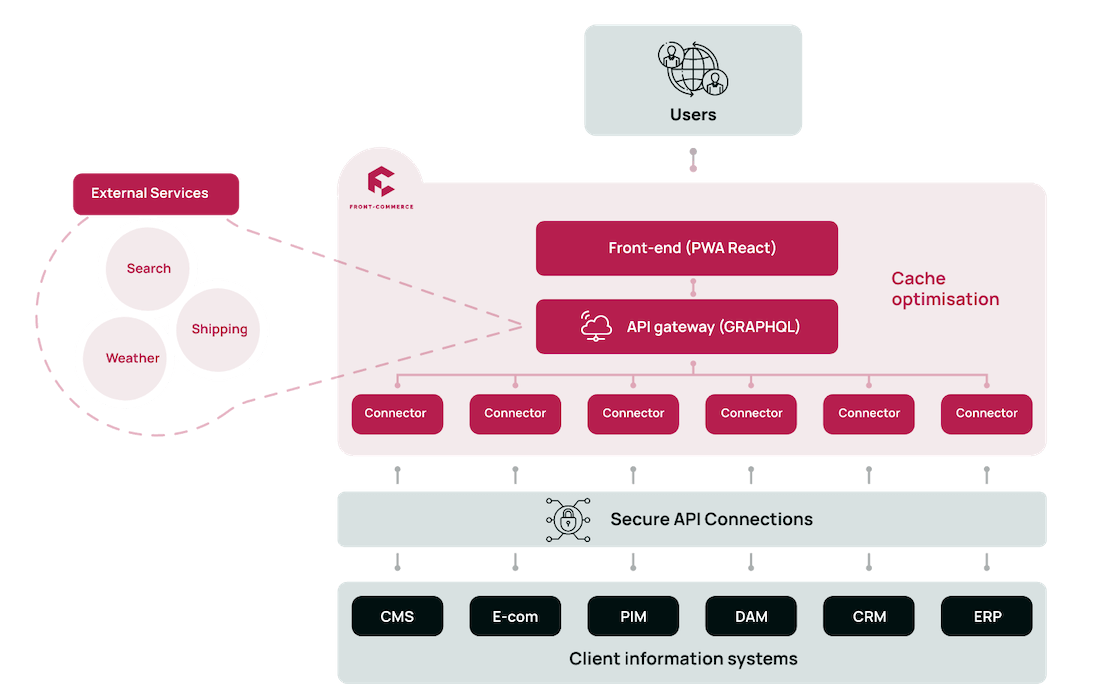If you work in e-commerce or web development, you’ve heard of Composable Commerce. With adaptability and agility becoming increasingly important for online businesses looking to grow, companies are moving away from the traditional monolithic approach to eCommerce platforms. Composable Commerce has emerged to address this need for change, offering a flexible and agile approach to online business.
Everything you need to know about Composable Commerce
The Traditional Approach to Ecommerce & the Rise of Composable Commerce
When we think of traditional eCommerce platforms, we envision monolithic systems that encompass various functionalities, such as inventory management, order processing, and customer management, all tightly integrated into a single, rigid framework. While these platforms have served businesses well in the past, they often come with limitations and drawbacks that hinder growth and innovation. Customising these platforms is time-consuming and costly, requiring extensive coding and development work. Moreover, changes made to one aspect of the system can cause disruptions elsewhere due to the tightly integrated nature.
Enter Composable Commerce, a step away from the traditional approach that emphasizes the composition and integration of modular, independent software applications (SaaS apps) for specific eCommerce functionalities. Instead of relying on a single platform, businesses can leverage specialized best-of-breed SaaS apps that seamlessly work together, creating a tailored eCommerce ecosystem.
Composable Commerce offers unparalleled flexibility, allowing businesses to select and integrate only the necessary SaaS apps. This enables quick iterations and rapid responses to market changes. It also provides versatility, freeing businesses from being tied to a single vendor or technology stack. With a wide array of specialized SaaS apps available, companies can experiment with different solutions and optimize their digital commerce operations.
Embracing Composable Commerce allows businesses to break free from the limitations of traditional eCommerce platforms. With Composable Commerce comes a shift towards flexibility, versatility, experimentation and agility in digital commerce. By leveraging a variety of specialized SaaS apps, companies can create a customized eCommerce architecture that suits their specific requirements, adapt quickly to market changes, and stay at the forefront of industry trends.

Here’s a snapshot of what a Composable Commerce architecture can look like.
Embracing Composable Commerce as a Mindset Shift
Composable Commerce is more than just an architectural model; it represents a mindset shift in how businesses approach digital commerce. One of the key aspects of this mindset shift is challenging the notion of relying solely on monolithic eCommerce or in-store technology. It encourages businesses to adopt a more holistic view of their entire digital commerce systems, going beyond just their eCommerce website. This means leveraging capabilities across all digital touchpoints with customers, such as mobile apps, social media platforms, and marketplaces, to provide a seamless and consistent customer experience.
Embracing Composable Commerce requires a shift in thinking from a static state that must be achieved to an ongoing process of evolution. Digital commerce is continuously evolving, and businesses need to stay adaptable and open to incorporating new technologies and strategies. Composable Commerce empowers companies to evolve their digital commerce capabilities iteratively, ensuring they can keep up with changing customer expectations and market trends.
In addition to the technical aspects, the mindset shift towards Composable Commerce also emphasises the importance of focusing on the customer experience rather than getting caught up in the technology itself. While the choice and integration of SaaS apps are crucial, the ultimate goal is to create a seamless and personalised experience for customers across all touchpoints. This customer-centric approach drives loyalty, engagement, and ultimately, business success.

Composable Commerce: Unleash the growth of your e-commerce
Key takeaways
- The traditional approach to eCommerce platforms with monolithic systems is becoming outdated, and businesses need a more flexible and agile approach.
- Composable Commerce is a mindset shift that emphasizes the composition and integration of modular, independent best-of-breed SaaS apps for specific eCommerce functionalities.
- Embracing Composable Commerce allows businesses to tailor their eCommerce ecosystem, selecting and integrating only the necessary SaaS apps for greater flexibility and agility.
- The shift towards Composable Commerce requires businesses to adopt a holistic view of their entire digital commerce systems, going beyond the eCommerce website.
- Digital maturity is crucial to effectively manage the complexity of multiple integrations and touchpoints in the Composable Commerce ecosystem.
- The focus should always be on the customer experience, with technology serving as an enabler rather than the sole focus.
- Embracing Composable Commerce is an ongoing process of evolution and innovation, requiring businesses to stay adaptable and open to new technologies and strategies.
By embracing the Composable Commerce mindset, businesses can unlock the benefits of flexibility, versatility, and agility in their digital commerce operations. They can create tailored eCommerce ecosystems, provide seamless customer experiences across all touchpoints, and stay ahead of the competition in a rapidly changing digital landscape.

